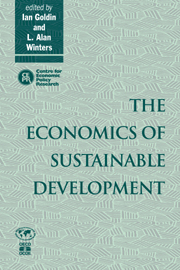Book contents
- Frontmatter
- Contents
- List of figures
- List of tables
- Preface
- Acknowledgements
- List of conference participants
- 1 Economic policies for sustainable development
- PART ONE GROWTH AND THE ENVIRONMENT
- PART TWO SUSTAINABILITY
- 4 What sustains economic development?
- Discussion
- 5 Optimal development and the idea of net national product
- Discussion
- 6 Sustainable growth and the Green Golden Rule
- Discussion
- PART THREE DOMESTIC POLICY
- PART FOUR INTERNATIONAL POLICY COORDINATION
- Index
Discussion
Published online by Cambridge University Press: 04 August 2010
- Frontmatter
- Contents
- List of figures
- List of tables
- Preface
- Acknowledgements
- List of conference participants
- 1 Economic policies for sustainable development
- PART ONE GROWTH AND THE ENVIRONMENT
- PART TWO SUSTAINABILITY
- 4 What sustains economic development?
- Discussion
- 5 Optimal development and the idea of net national product
- Discussion
- 6 Sustainable growth and the Green Golden Rule
- Discussion
- PART THREE DOMESTIC POLICY
- PART FOUR INTERNATIONAL POLICY COORDINATION
- Index
Summary
This is a very stimulating chapter. My Discussion reviews the various approaches to the notion of sustainable growth and locates Dasgupta's in relation to them; it then raises a few questions.
There are various approaches to constructing a measure of ‘sustainable growth’. For example, Nordhaus has listed these various approaches, starting with the early environmentalist approach of the Brundtland Commission, which according to him emphasized the Pareto criterion. This defines ‘sustainable growth’ as meeting the needs of present generations without compromising the ability of future generations to meet their own needs. The Pareto criterion is satisfied by many paths, and if we want something narrower we should look elsewhere. The Rawlsian approach aims to maximise the wealth of the most disadvantaged. The most disadvantaged are the future generations, so in this approach you would want to ensure that the consumption of future generations will not decline. Consumption should include all kinds of goods, but if one includes social goods, such as health, nutrition, and education, one runs into the problem of constructing an index of social welfare.
The Hicksian approach is easier to deal with. It is defined as the maximum amount which can be spent by current generations without impoverishing future consumers. There are various ways of defining ‘expenditure’ – the simplest is to say consumption + investment – depreciation. The problem with the Hicksian notion of sustainable income is deciding what one wishes to keep intact. For example, is it capital, real money, or the purchasing power of future generations, and if it is capital how does one define it? When one talks about income does one talk about private or social income?
- Type
- Chapter
- Information
- The Economics of Sustainable Development , pp. 143 - 146Publisher: Cambridge University PressPrint publication year: 1995



